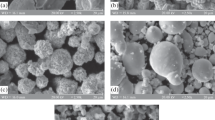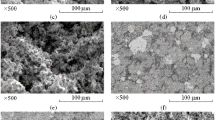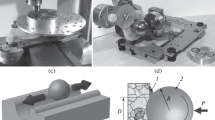The structural features, hardness, elastic modulus, and wear resistance of Fe–Cu–Ni–Sn composites with different CrB2 contents, produced by cold pressing and subsequent sintering with additional hot pressing, were studied by X-ray diffraction, scanning electron microscopy, microindentation, and tribological testing. The micromechanical and tribological tests were performed on composite samples 10 mm in diameter and 5 mm thick in dry friction conditions. The test results showed that the mechanical and tribological properties of the composites depended on the CrB2 content. The microhardness and elastic modulus of the samples varied from 1.2 to 9.2 GPa and from 110 to 245 GPa, respectively, depending on their composition, resulting from the uneven distribution of α-Fe, Cu, Cu9NiSn3, NiSn3, and CrB2 phases. The addition of 2 wt.% CrB2 to the 51Fe–32Cu–9Ni– 8Sn composite increased its hardness from 1.2–2.8 GPa to 2.0–4.5 GPa and the elastic modulus from 110–190 GPa to 130–200 GPa and decreased the wear rate from 22.93 ∙ 10–3 to 10.19 × 10–3 mm3 ∙ N–1 ∙ m–1. The mechanism of increasing the wear resistance of the composite sample containing 2 wt.% CrB2 in comparison with the starting composite was associated with the refinement of iron and copper grains from 5–40 μm to 2–10 μm and the presence of discrete areas of greater hardness and higher elastic modulus. A further increase in the CrB2 content from 2 to 8 wt.% in the composite was accompanied by a simultaneous increase in hardness from 2.0–4.5 GPa to 4.8–9.2 GPa, elastic modulus from 130–200 GPa to 150–245 GPa, and wear rate from 10.19 ×10–3 to 16.68 ∙10–3 mm3 ∙ N–1 ∙ m–1. The higher wear rate of these composites was due to excessive brittleness caused by excessive CrB2 content.









Similar content being viewed by others
References
Meng Li, Youhong Sun, Qingnan Meng, Haidong Wu, Ke Gao, and Baochang Liu, “Fabrication of Febased diamond composites by pressureless infiltration,” Materials, 9, 1006 (2016).
D. Duan, B. Xiao, B. Wang, P. Han, W. Li, and S. Xia, “Microstructure and mechanical properties of prebrazed diamond abrasive grains using Cu–Sn–Ti alloy,” Int. J. Refract. Met. Hard Mater., 48, 427–432 (2015).
Xiaojun Zhao and Longchen Duan, “A review of the diamond retention capacity of metal bond matrices,” Metals, 8, No. 5, 307–329 (2018).
Z. Nitkiewicz and M. Swierzy, “Tin influence on diamond-metal matrix hot pressed tools for stone cutting,” J. Mater. Proc. Tech., 175, No. 1-3, 306-315 (2006).
V.A. Mechnik, “Diamond–Fe–Cu–Ni–Sn composite materials with predictably stable characteristics,” Mater. Sci., 48, No. 5, 591–600 (2013).
V.A. Mechnik, “Production of diamond-(Fe-Cu-Ni-Sn) composites with high wear resistance,” Powder Metall. Met. Ceram., 52, No. 9-10, 577-587 (2014).
J. Borowiecka-Jamrozek, “Microstructure and mechanical properties a new iron-base material used for the fabrication of sintered diamond tools,” Adv. Mater. Res., 1052, 520–523 (2014).
J. Borowiecka-Jamrozek and J. Lachowski, “Modelling of the mechanical state of a diamond particle in the metallic matrix,” Adv. Mater. Res., 874, 127–132 (2014).
M.O. Bondarenko, V.A. Mechnik, and M.V. Suprun, “Shrinkage and shrinkage rate behavior in Cdiamond–Fe–Cu–Ni–Sn–CrB2 system during hot pressing of pressureless-sintered compacts,” J. Superhard Mater., 31, No. 4, 232-240 (2009).
A.A. Zaitsev, D.A. Sidorenko, E.A. Levashov, V.V. Kurbatkina, V.A. Andreev, S.I. Rupasov, and P.V. Sevast’yanov, “Diamond tools in metal bonds dispersion-strengthened with nanosized particles for cutting highly reinforced concrete,” J. Superhard Mater., 32, No. 6, 423-431 (2010).
A.A. Zaitsev, D.A. Sidorenko, E.A. Levashov, V.V. Kurbatkina, S.I. Rupasov, V.A. Andreev, and P.V. Sevast’yanov, “Development and application of the Cu–Ni–Fe–Sn based dispersion hardened bond for cutting tools of superhard materials,” J. Superhard Mater. 34, No. 4, 270–280 (2012).
V.A. Mechnik, N.A. Bondarenko, N.O. Kuzin, and B.A. Lyashenko, “The role of structure formation in forming the physicomechanical properties of composites of the diamond–(Fe–Cu–Ni–Sn) system,” J. Frict. Wear, 37, No. 4, 377–384 (2016).
I. Dinaharan, R. Sathiskumar, and N. Murugan, “Effect of ceramic particulate type on microstructure and properties of copper matrix composites synthesized by friction stir processing,” J. Mater. Res. Technol., 5, No. 4, 302–316 (2016).
A.M. Hodge, Y.M. Wang, and T.W. Barbee, “Large-scale production of nano-twinned, ultrafine-grained copper,” Mater. Sci. Eng. A, 429, No. 1–2, 272–276 (2006).
E. Levashov, V. Kurbatkina, and A. Zaytsev, “Improved mechanical and tribological properties of metalmatrix composites dispersion-strengthened by nanoparticles,” Materials, 3, No. 1, 97–109 (2010).
Leon L. Shaw, Juan Villegas, Jian-Yu Huang, and Shuo Chen, “Strengthening via deformation twinning in a nickel alloy,” Mater. Sci. Eng. A, 480, No. 1–2, 75–83 (2008).
V.A. Aleksandrov, N.A. Akekseenko, and V.A. Mechnik, “Study of force and energy parameters in cutting granite with diamond disc saws,” Sov. J. Superhard Mater., 6, No. 6, 46–52 (1984).
V.A. Dutka, V.M. Kolodnitskij, O.V. Mel’nichuk, and S.D. Zabolotnyj, “Mathematical model for thermal processes occurring in the interaction between rock destruction elements of drilling bits and rock mass,” Sverkhtverd. Mater., No. 1, 67–77 (2005).
M. Uemura, “An analysis of the catalysis of Fe, Ni or Co on the wear of diamonds,” Tribol. Int., 37, No. 11–12, 887–892 (2004).
D.A. Sidorenko, A.A. Zaitsev, A.N. Kirichenko, E.A. Levashov, V.V. Kurbatkina, P.A. Loginov, S.I. Rupasov, and V.A. Andreev, “Interaction of diamond grains with nanosized alloying agents in metal–matrix composites as studied by Raman spectroscopy,” Diamond Relat. Mater., 38, 59-62 (2013).
H. Dai, L. Wang, J. Zhang, Y. Liu, Y. Wang, L. Wang, and X. Wan, “Iron based partially pre-alloyed powders as matrix materials for diamond tools,” J. Powder Metall., 58, 83–86 (2015).
A. Gant, I. Konyashin, B. Ries, A. McKie, R. Nilen, and J. Pickles, “Wear mechanisms of diamondcontaining hardmetals in comparison with diamond-based materials,” Int. J. Refract. Met. Hard Mater., 71, 106–114 (2018).
Q.L. Dai, C.B. Luo, X.P. Xu, and Y.C. Wang, “Effects of rare earth and sintering temperature on the transverse rupture strength of Fe-based diamond composites,” J. Mater. Proc. Technol., 129, 427–430 (2002).
V.A. Mechnik, N.A. Bondarenko, N.O. Kuzin, and E.S. Gevorkian, “Influence of the addition of vanadium nitride on the structure and specifications of a diamond–(Fe–Cu–Ni–Sn) composite system,” J. Frict. Wear, 39, No. 2, 108–113 (2018).
Y. Han, S. Zhang, R. Bai, H. Zhou, Z. Su, J. Wu, and J. Wang, “Effect of nano-vanadium nitride on microstructure and properties of sintered Fe–Cu-based diamond composites,” Int. J. Refract. Met. Hard Mater., 91, 105256 (2020).
V.A. Mechnik, N.A. Bondarenko, S.N. Dub, V.M. Kolodnitskyi, Yu.V. Nesterenko, N.O. Kuzin, I.M. Zakiev, and E.S. Gevorkyan, “A study of microstructure of Fe–Cu–Ni–Sn and Fe–Cu–Ni–Sn–VN metal matrix for diamond containing composites,” Mater. Charact., 146, 209-216 (2018).
L.J. de Oliveira, R.P.R. da Paranhos, R.S. da Guimarães, G.S. Bobrovnitchii, and M. Filgueira, “Use of PM Fe–Cu–SiC composites as bonding matrix for diamond tools,” J. Powder Metall., 50, 148–152 (2007).
M. Simsir and K.E. Öksüz, “Effects of sintering temperature and addition of Fe and B4C on hardness and wear resistance of diamond reinforced metal matrix composites,” J. Superhard Mater., 35, 369–382 (2013).
V.A. Mechnik, “Regularities of structure formation in diamond–Fe–Cu–Ni–Sn–CrB2 systems,” Mater. Sci., 49, No. 1, 93–101 (2013).
V.A. Mechnik, “Effect of hot recompaction parameters on the structure and properties of diamond–(Fe–Cu–Ni–Sn–CrB2) composites,” Powder Metall. Met. Ceram., 52, No. 11-12, 709-721 (2014).
V.A. Mechnik, N.A. Bondarenko, V.M. Kolodnitskyi, V.I. Zakiev, I.M. Zakiev, S.R. Ignatovich, and S.S. Yutskevych, “Mechanical and tribological properties of Fe–Cu–Ni–Sn materials with different amounts of CrB2 used as matrices for diamond-containing composites,” J. Superhard Mater., 42, No. 4, 251–263 (2020).
W. Kraus and G. Nolze, “Powder Cell-A program for the representation and manipulation of crystal structures and calculation of the resulting X-ray powder patterns,” J. Appl. Cryst., 29, 301-303 (1996).
Selected Powder Diffraction Data for Education Straining (Search Manual and Data Cards), International Centre for Diffraction Data, USA (1988), p. 432.
I. Zakiev and E. Aznakayev, “Micro Gamma: The device for the estimation of physico-mechanical properties of materials,” J. Assoc. Lab. Autom., 7, No. 5, 44–45 (2002).
W.C. Oliver and G.M. Pharr, “An improved for determining hardness and elastic modulus using load and displacement sensing indentation experiments,” J. Mater. Res., 7, No. 6, 1564–1583 (1992).
S.A. Firstov, S.R. Ignatovich, and I.M. Zakiev, “Size effect in the micro- and nanoindentation and its compensation with regard for the specific features of initial contact,” Strength Mater., 41, No. 2, 147–155 (2009).
V. Zakiev, A. Markovsky, E. Aznakayev, I. Zakiev, and E. Gursky, “Micro-mechanical properties of biomaterials,” in: Proc. SPIE 5959, Medical Imaging, 595916, Congress on Optics and Optoelectronics (September 23, 2005), Warsaw, Poland (2005).
I. Zakiev, G.A. Gogotsi, M. Storchak, and V. Zakiev, “Glass fracture during micro-scratching,” Surfaces, 3, 211–224 (2020).
V. Fuertes, M.J. Cabrera, J. Seores, D. Muñoz, J.F. Fernández, and E. Enríquez, “Enhanced wear resistance of engineered glass-ceramic by nanostructured self-lubrication,” Mater. Des., 168, 107623 (2019).
ASTM G99-17, Standard Test Method for Wear Testing with a Pin-on-Disk Apparatus, ASTM International, West Conshohocken, PA (2017).
ASTM G171-03, Standard Test Method for Scratch Hardness of Materials Using a Diamond Stylus, ASTM International, West Conshohocken, PA (2017).
R. P. Seelig, “Fundamentals of pressing of metal powder,” in: W. E. Kingston (ed.), The Physics of Powder Metallurgy, Book Comp. Inc., McGraw-Hill (1951), pp. 344-371.
O. Radionenko, M. Kindrachuk, O. Tisov, and A. Kryzhanovskyi, “Features of transition modes of friction surfaces with partially regular microrelief,” Aviation, 22, No. 3, 86–92 (2018).
E.F. Perepl’otchikov, K.B. Vasyliv, V.A. Vynar, I.O. Ryabtsev, and V.I. Zakiev, “Elevation of the wear resistance of low-alloy structural steel by plasma-powder surfacing with alloys based on iron, chromium, and nickel,” Mater. Sci., 54, 378–386 (2018).
L.I. Ivshchenko, V.V. Tsyganov, and I.M. Zakiev, “Features of the wear of tribojoints under threedimensional loading,” J. Frict. Wear, 32, No. 1, 8–16 (2011).
K. Kusumoto, K. Shimizu, V.G. Efremenko, H. Hara, M. Shirai, Jun Ito, Hatate M. Yilag aqi, and R.H. Purba, “Three body type abrasive wear characteristics of multi-component white cast irons,” Wear, 426–427, 122–127 (2019).
Acknowledgement
The research has been conducted under R&D projects in compliance with coordination plans of the Ministry of Education and Science of Ukraine (state registration No. 0120U100105).
Author information
Authors and Affiliations
Corresponding author
Additional information
Translated from Poroshkova Metallurgiya, Vol. 60, Nos. 3–4 (538), pp. 95–109, 2021.
Rights and permissions
About this article
Cite this article
Mechnik, V., Bondarenko, N., Kolodnitskyi, V. et al. Microstructural Features and Mechanical and Tribological Properties of Fe–Cu–Ni–Sn Composites Precipitation-Hardened with CrB2 Additions. Powder Metall Met Ceram 60, 204–215 (2021). https://doi.org/10.1007/s11106-021-00229-x
Received:
Published:
Issue Date:
DOI: https://doi.org/10.1007/s11106-021-00229-x




